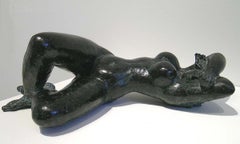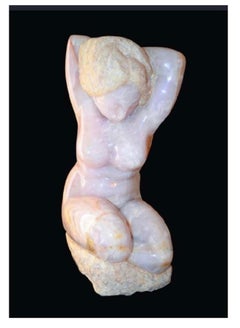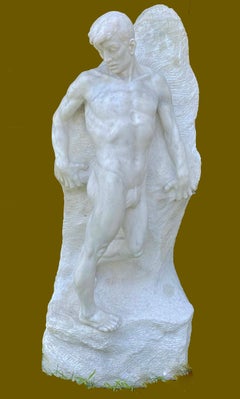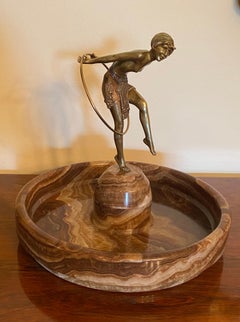Want more images or videos?
Request additional images or videos from the seller
1 of 5
Ulises Jimenez ObregonRebecca2000
2000
$7,500List Price
About the Item
About the Seller
5.0
Vetted Professional Seller
Every seller passes strict standards for authenticity and reliability
Established in 1972
1stDibs seller since 2011
409 sales on 1stDibs
Authenticity Guarantee
In the unlikely event there’s an issue with an item’s authenticity, contact us within 1 year for a full refund. DetailsMoney-Back Guarantee
If your item is not as described, is damaged in transit, or does not arrive, contact us within 7 days for a full refund. Details24-Hour Cancellation
You have a 24-hour grace period in which to reconsider your purchase, with no questions asked.Vetted Professional Sellers
Our world-class sellers must adhere to strict standards for service and quality, maintaining the integrity of our listings.Price-Match Guarantee
If you find that a seller listed the same item for a lower price elsewhere, we’ll match it.Trusted Global Delivery
Our best-in-class carrier network provides specialized shipping options worldwide, including custom delivery.You May Also Like
Chaim Gross Mid Century Mod Bronze Sculpture Mother and Baby Playing WPA Artist
By Chaim Gross
Located in Surfside, FL
Chaim Gross (American, 1904-1991)
Cast bronze sculpture
Caring (or Mother and Child)
signed
Mounted on wooden plinth
Featuring a mother raising her child up in superb high relied i...
Category
Mid-20th Century American Modern Figurative Sculptures
Materials
Bronze
$2,400
H 9 in W 7.5 in D 3.5 in
Two Women
By Robert Lohman
Located in Indianapolis, IN
Lohman studied at John Herron Art Institute, and Cranbrook and Yale for graduate work. Assisted Carl Milles at Cranbrook Academy before becoming Director of Fine Arts there from 1947...
Category
1950s Modern Nude Sculptures
Materials
Wood
Sydney Kumalo Bronze Minimalist African Modernist Sculpture Figural Female Nude
Located in Surfside, FL
Sydney Kumalo. Features a bronze stylized female figural form sculpture fixed to a marble plinth and wood base. Bears signature on base. Measures 9 1/2" x 4 1/4". There is no edition number on the piece.
Sydney Kumalo (1935 - 1988) was born in Sophiatown, Johannesburg, on 13 April 1935. His was one of the families who had to move out of the "white" city to the South Western Townships, or Soweto. Raised in Diepkloof and educated at Madibane High School, he took with him from old Sophiatown the curious and diverse heritage of its heyday. Art classes in the Catholic school, "Sof' town" blues and jazz, the vibrant street culture and growing defiance of its population of various races who were gradually forced out into separate race-group areas. So it was that these various aspects of his early life created for Kumalo a cultural mix of a Zulu family related to the traditional royal house; city schooling, nascent township music and lingo; growing urbanised political defiance and the deep-rooted Zulu pride and respect for the legends and ancient stories of a tribal people. This mix of old and new cultures was reinforced when he began his studies at the Polly Street Art Centre in 1953 where he became a member of Cecil Skotnes group of serious artists who were encouraged to acquire professional skills. Skotnes introduced a basic training programme with modelling as a component, which marked the introduction of sculpting (in brick-clay) at Polly Street.
Kumalo was Skotnes’ assistant at Polly Street from 1957 to 1964, and having recognised his great talent as a sculptor, Skotnes encouraged him to become a professional artist.
After Kumalo’s very successful assistance with a commission to decorate the St Peter Claver church at Seeisoville near Kroonstad, with painting designs, sculpture and relief panels in 1957, Skotnes arranged for Kumalo to continue his art training by working in Edoardo Villa ’s studio from 1958 to 1960. Working with Villa, he received professional guidance and began to familiarize himself with the technical aspects of sculpting and bronze casting. In 1960 he became an instructor at the Polly Street Art Centre.
Kumalo started exhibiting his work with some of the leading commercial Johannesburg galleries in 1958, and had his first solo exhibition with the Egon Guenther Gallery in 1962. He was a leader of the generation who managed to leave behind the forms of African curios, reject the European-held paternalism which encouraged notions of "naive" and "tribal" African art, and yet still hold fast to the core of the old legends and spiritual values of his people. He introduced these subjects into his bronze sculptures and pastel drawings, evolving his own expressive, contemporary African "style".
Together with Skotnes, Villa, Cecily Sash and Giuseppe Cattaneo, Kumalo became part of the Amadlozi group in 1963. This was a group of artists promoted by the African art collector and gallery director Egon Guenther, and characterised by their exploration of an African idiom in their art. Elza Miles writes that Cecil Skotnes’ friendship with Egon Guenther had a seminal influence on the aspirant artists of Polly Street: “Guenther broadened their experience by introducing them to German Expressionism as well as the sculptural traditions of West and Central Africa. He familiarised them with the work of Ernst Barlach, Käthe Kollwitz, Gustav Seitz, Willi Baumeister and Rudolf Sharf.” It is therefore not surprising that some of Kumalo’s sculptures show an affinity with Barlach’s powerful expressionist works. Guenther organised for the Amadlozi group to hold exhibitions around Italy, in Rome, Venice, Milan and Florence, in both 1963 and 1964.
Kumalo’s career took off in the mid 1960s, with his regular participation in exhibitions in Johannesburg, London, New York and Europe. He also represented South Africa at the Venice Biennale in 1966, and in 1967 participated in the São Paulo Biennale.
EJ De Jager (1992) describes Kumalo’s sculpture as retaining much of the “canon and formal aesthetic qualities of classical African sculpture. His work contains the same monumentality and simplicity of form.” His main medium for modelling was terra cotta, which was then cast in bronze, always paying careful attention to the finish of both the model as well as the final cast. He began casting the pieces he modelled in clay or plaster into bronze at the Renzo Vignali Artistic Foundry in Pretoria North. He worked throughout his life with its owners, the Gamberini family, and enjoyed learning the technical aspects of the casting process, refining his surfaces according to what he learned would produce the best results in metal. De Jager further writes that Kumalo’s distinctive texturing of the bronze or terra cotta is reminiscent of traditional carving techniques of various African cultures. “In many respects Kumalo thus innovated a genuine contemporary or modern indigenous South African sculpture”. Kumalo came to admire the works of the Cubists, and of British sculptors Henry Moore and Lynn Chadwick. He became noted for adapting shapes from them into his own figures. The success of his use of the then current monumental simplicity and purely aesthetic abstractions of natural forms has been emulated by many South African sculptors since the 1970s.
He was in many ways the doyen of South African Black art. As such he was an important influence especially on younger African sculptors, by whom he is greatly revered. Through his teaching at Polly Street and at the Jubilee Centre, as well as through his personal example of integrity, dedication and ability, he inspired and guided students who in their own right became outstanding artists, for example, Ezrom Legae, Leonard Matsoso and Louis Maqhubela
From 1969 onward, he allied himself with Linda Givon, founder of The Goodman Gallery in Johannesburg, where he exhibited regularly until his death in December 1988. Working with Givon also perpetuated his associations with his many friends of strong principles. Skotnes, Villa, Legae and later such peers from the Polly Street era as Leonard Matsoso, Durant Sihlali and David Koloane have all exhibited at The Goodman Gallery. Kumalo, Legae, and later Fikile (Magadlela) and Dumile (Feni) were among the leading exponents of a new Afrocentric art...
Category
20th Century Modern Figurative Sculptures
Materials
Marble, Bronze
1961 Coty Award Plaque Kenneth Hairdresser Jacqueline Onassis Bronze Fashion
Located in New York, NY
1961 Coty Award Plaque Kenneth Hairdresser Jacqueline Onassis Bronze Fashion
Bronze on wood. The wood plaque measures 12 3/4" by 20 3/4 inches. The bronze plaque itself is 13 3/4 x 8 3/4 inches and the the bronze inscription, which reads "COTY, American Fashion Critics Special Award 1961 to KENNETH of LILY DACHE...
Category
1960s American Modern Figurative Sculptures
Materials
Bronze
$6,800 Sale Price
20% Off
H 21 in W 13 in
El Torso
Located in Zofingen, AG
The sculpture is dedicated to female beauty and grace. The author portrayed a beautiful girl who is a little shy about her nakedness. Her body is stylized. Polished bronze accentuate...
Category
Early 2000s Modern Figurative Sculptures
Materials
Marble, Metal, Bronze
Large Ceramic Clay Sculpture Of Striped Shirt In Man Size On Piedestal
Located in Frederiksberg C, DK
Large sized sculpture of a standing shirt including large piedestal.
Category
Late 20th Century American Modern Figurative Sculptures
Materials
Ceramic, Clay
$4,500
H 26.38 in W 24.81 in D 12.21 in
Monumental Italian Rationalist Marble Sculptures of Young Athletes
Located in Rome, IT
This monumental pair of sculptures in "Bardiglio" marble represent Greek Athletes figure , on a cylindrical base . Exaltation of the male strength and beauty, inspired by the trend i...
Category
1960s Modern Figurative Sculptures
Materials
Marble
Monumental Italian Rationalist Marble Sculptures of Young Athletes
Located in Rome, IT
This monumental pair of sculptures in "Bardiglio" marble represent Greek Athletes figure , on a cylindrical base . Exaltation of the male strength and beauty, inspired by the trend i...
Category
1960s Modern Figurative Sculptures
Materials
Marble
$51,694 Sale Price
20% Off
H 104.34 in Dm 31.5 in
Victor Salmones QUEEN OF SPACE Bronze Sculpture
By Victor Salmones
Located in Lake Worth Beach, FL
Artist/Designer; Manufacturer: Victor Salmones (Mexican, 1937-1984)
Marking(s); notes: signed; marking(s); ed. 1/10
Materials: bronze
Dimensions (H, W, D): 21"h, 10.75"w, 16.75"d; 36...
Category
20th Century Modern Nude Sculptures
Materials
Bronze
$7,600 Sale Price
20% Off
H 36 in W 11 in D 10 in
Woman - Sculpture - Mid-20th Century
Located in Roma, IT
Balinese bronze sculpture of woman.
Placed on a wooden pedestal.
Excellent condition.
Category
Mid-20th Century Modern Figurative Sculptures
Materials
Bronze
More From This Seller
View AllRECLINGING WOMAN
By Antoniucci Volti
Located in Los Angeles, CA
ANTONIUCCI VOLTI
"RECLINGING WOMAN"
BRONZE, SIGNED, NUMBERED 2/6
VALSUANI FOUNDRY
ITALiAN, WORKED IN PARIS, C.1960
6.5 X 18.5 X 10.5 INCHES
Antoniucci Volti
1915-1989
Sculptor, painter, and printmaker Antoniucci Volti was born in Albano, Italy, in 1915. His family lived in Italy until 1920 when the family moved to France.
Volti studied at the Ecole des Arts Décoratifs in Nice from 1928 to 1920. By 1932 the young artist had won a gold medal for two polychrome bas-reliefs before going to Paris, where he entered the studio of Jean Boucher at the Ecole Nationale des Beaux-Arts in Paris at the age of only fifteen.
After serving in the Second World War, when he was interned as a prisoner of war in Bavaria, he returned in poor health to Paris, only to find his studio destroyed.
From 1947 he showed work at various Paris Salons and, in 1954 and 1955 at the Brussels and Antwerp Biennales. In 1957 a retrospective of his work was organized at the Museum Rodin in Paris.
He died in Paris in 1989 Works by Volti are in leading museums such as the Musée National d'Art Moderne, Paris. Antoniucci Volti is one of the most important Late Modern...
Category
1960s Modern Nude Sculptures
Materials
Bronze
$23,600 Sale Price
20% Off
Kneeling Nude
By Bernard Simon
Located in Los Angeles, CA
Primarily a figure sculptor in marble and wood, he was born in Russia. In New York City, he studied at the Educational Alliance and Art Workshop and was active in numerous art associ...
Category
1960s Modern Nude Sculptures
Materials
Stone
$3,738 Sale Price
34% Off
L'ABISSO
Located in Los Angeles, CA
Document from the Nashvile Art Association dated 1925. The marble was purchased in Florence, Italy at an exhibit of The Association of of Italian Artists.
Category
1920s Art Deco Figurative Sculptures
Materials
Marble
Hoop Dancer
By Demetre Chiparus
Located in Los Angeles, CA
Demetre Haralamb Chiparus (also known as Dumitru Chiparus) (16 September 1886 in Dorohoi, Romania - 22 January 1947 in Paris, France) was a Romanian Art Deco* era sculptor who lived and worked in Paris.
He was born in Romania, the son of Haralamb and Saveta. In 1909 he went to Italy, where he attended the classes of Italian sculptor Raffaello Romanelli. In 1912 he traveled to Paris to attend the Ecole des Beaux Arts* to pursue his art at the classes of Antonin Mercie and Jean Boucher.
Demetre Chiparus died in 1947 and was buried in Bagneux cemetery, just south of Paris.
The first sculptures of Chiparus were created in the realistic style and were exhibited at the Salon of 1914. He employed the combination of bronze and ivory, called chryselephantine*, to great effect. Most of his renowned works were made between 1914 and 1933. The first series of sculptures manufactured by Chiparus were the series of the children.
The mature style of Chiparus took shape beginning in the 1920s. His sculptures are remarkable for their bright and outstanding decorative effect. Dancers of the Russian Ballet, French theatre, and early motion pictures were among his more notable subjects and were typified by a long, slender, stylized appearance. His work was influenced by an interest in Egypt, after Pharaoh Tutankhamen's tomb was excavated.
He worked primarily with the Edmond Etling and Cie Foundry in Paris administrated by Julien Dreyfus. Les Neveux de J. Lehmann was the second foundry which constantly worked with Chiparus and produced the sculptures of his models.
Chiparus rarely exhibited at the Salon. In 1923 he showed his Javelin Thrower, and in 1928 exhibited his Ta-Keo dancer. During the period of Nazi persecution and the World War II, the foundries discontinued production of work by Chiparus. The economic situation of that time was not favorable to the development of decorative arts and circumstances for many sculptors worsened.
Since the early 1940s almost no works of Chiparus were sold, but he continued sculpting for his own pleasure, depicting animals in the Art Deco style. At the 1942 Paris Salon, the plaster sculptures Polar Bear and American Bison were exhibited, and in 1943 he showed a marble Polar Bear and plaster Pelican.
Sculptures of Dimitri Chiparus represent the classical manifestation of Art Deco style in decorative bronze ivory sculpture. Traditionally, four factors of influence over the creative activity of the artist can be distinguished: Serge Diaghilev's Ballets Russes, ancient Egyptian art, and French theatre. Early motion pictures were among his more notable subjects and were typified by figures with a long, slender, stylized appearance. Some of his sculptures were directly inspired by Russian dancers.
Quite often, Chiparus used the photos of Russian and French dancers, stars and models from fashion magazines of his time.
After the tomb of Tutankhamun was discovered in 1922, the art of ancient Egypt...
Category
1920s Art Deco Figurative Sculptures
Materials
Marble, Bronze
$4,400 Sale Price
20% Off
Nude
By Lorrie Goulet
Located in Los Angeles, CA
A beautiful rendition of a seated female nude in polished and chiseled marble.
Signed and dated 1981 on the back.
Stone, wood and ceramics sculptor Lorrie Goulet, who also makes draw...
Category
1980s Modern Nude Sculptures
Materials
Marble
$7,500
Nude Torso
By Lorrie Goulet
Located in Los Angeles, CA
A tall dynamic chipped wood standing nude torso mounted on a stone base.
Great form and patina.
Stone, wood and ceramics sculptor Lorrie Goulet, who also makes drawings and lithograp...
Category
1970s Abstract Nude Sculptures
Materials
Stone



